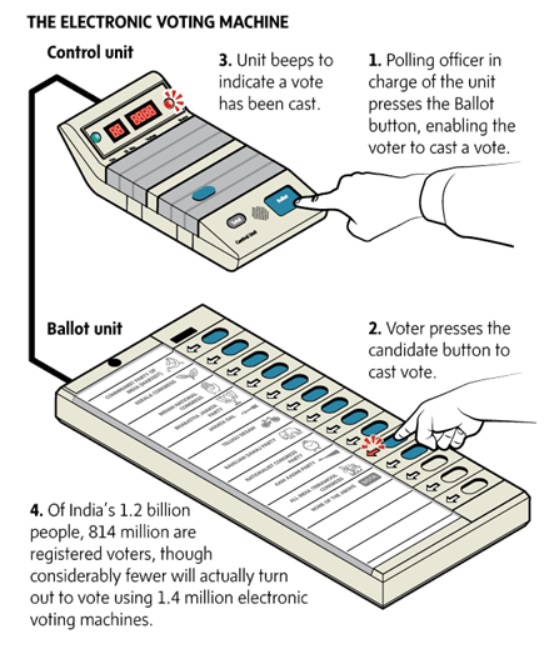Electronic Voting Machine (EVM) hardware refers to the physical components that make up the EVM system used in elections. The hardware is designed to facilitate secure and efficient voting and vote counting. Here are the primary components of EVM hardware.The primary components, including the Ballot Unit, Control Unit, and VVPAT, work together to ensure a seamless and trustworthy voting experience. The hardware is designed with multiple security features and is portable and tamper-proof to maintain the integrity of the voting process.

Main Components of electronic voting machine hardware
Ballot Unit (BU):
Keypad/Buttons: Allows voters to select their preferred candidates. Each button corresponds to a different candidate.
Candidate Display Panel: Displays the list of candidates with their respective symbols and names next to the buttons.
Control Unit (CU):
Display Panel: Shows information like the number of votes cast, errors, and status messages.
Result Section: Used to display the results after the election.
Control Buttons: Include buttons for starting the voting process, closing the voting at the end of the election, and accessing the stored votes.
Battery/Power Supply: Ensures the machine can operate independently of external power sources.
Voter-Verified Paper Audit Trail (VVPAT):
Printer Unit: Prints a paper slip showing the voter’s choice, which is then visible through a window for verification before dropping into a sealed box.
Paper Roll: Stores the printed slips for later verification if needed.
Additional Components of electronic voting machine hardware
Interconnecting Cable:
Connects the Ballot Unit to the Control Unit, ensuring communication between the two.
Seals and Locks:
Used to secure the EVM and prevent unauthorized access or tampering.
Carrying Cases:
Protect the hardware during transport and storage, ensuring the components remain secure and undamaged.
Functions and Features of electronic voting machine hardware
Standalone Operation:
EVMs are designed to operate independently without network connections, reducing the risk of hacking.
Tamper-Proof Design:
EVMs include physical and software security measures to prevent tampering and unauthorized access.
Portability:
The hardware is compact and portable, allowing it to be easily transported to different polling stations.
Security Measures of electronic voting machine hardware
Encryption of E-voting machine hardware:
Data transmitted between the Ballot Unit and Control Unit is encrypted to ensure security.
Seals and Authentication of electronic voting machine hardware:
Tamper-evident seals and authentication protocols ensure that the machines have not been tampered with between setup and use.
Physical Security of EVM hardware:
Robust construction and secure storage during and after elections help protect the hardware from damage and tampering.
Summary
Electronic Voting Machine hardware is a crucial component of modern electoral systems, designed to facilitate efficient, accurate, and secure voting. The primary components, including the Ballot Unit, Control Unit, and VVPAT, work together to ensure a seamless and trustworthy voting experience. The hardware is designed with multiple security features and is portable and tamper-proof to maintain the integrity of the voting process.
Home – IT solutions (rdmtech.in)